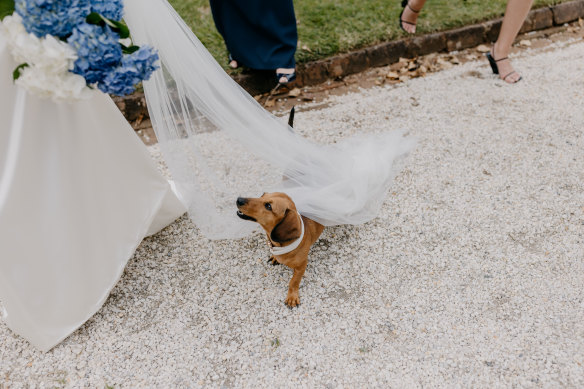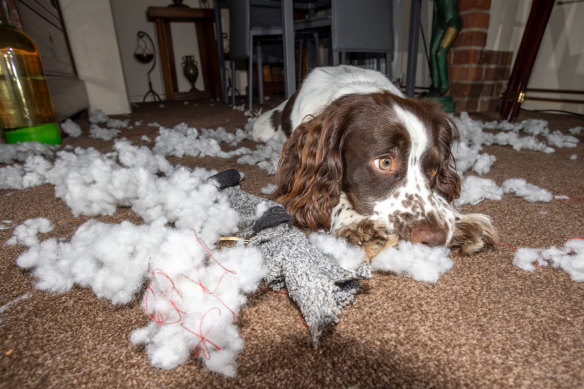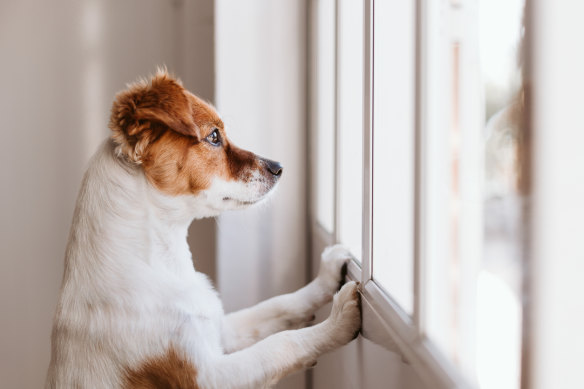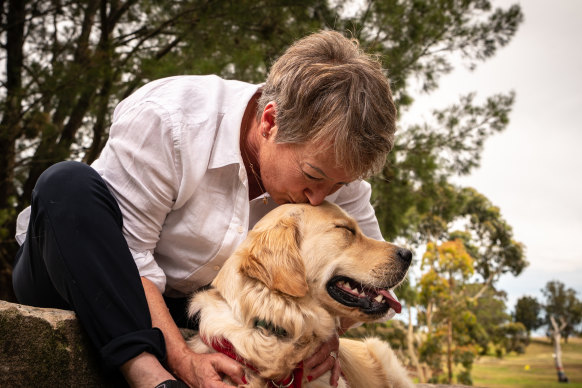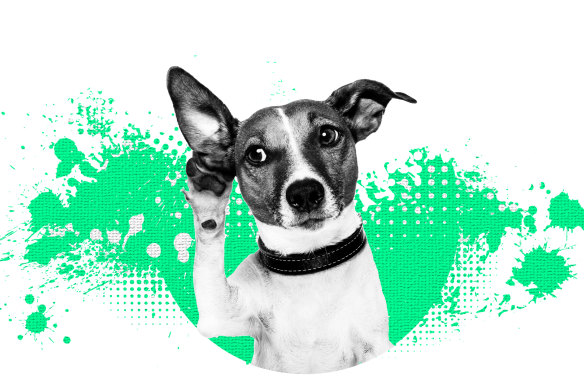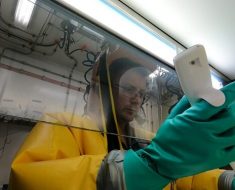By Lissa Christopher
Pickles the miniature dachshund plays the role of wedding ring bearer.Credit: Blaise Bell Photography
Save articles for later
Add articles to your saved list and come back to them any time.
Pickles’ arrival was a double delight for Maggie Andrezejewska. The miniature dachshund puppy was a surprise gift from her partner, Jacob Curran, who had printed “Will you marry me?” on the tag on the dog’s collar.
They both adore the tiny hound (who was the ring bearer at their recent wedding), but about 18 months after Pickles first entered their lives, they moved house and things took a difficult turn. Pickles would become horribly distressed whenever Andrezejewska went to leave the house and could be heard howling, pitifully and incessantly, from metres down the street.
Pickles had developed separation anxiety and if you’ve ever had or come close to having a panic attack, you’ll understand how awful the little dog was feeling.
“It’s essentially a panic attack in response to being left alone,” says Jenny Harlow, one of few specialist separation-anxiety trainers in Australia and the first to receive certification from Malena DeMartini-Price, a renowned US expert and author of the bestselling Treating Separation Anxiety in Dogs.
Destroying furnishings is a common symptom of canine separation anxiety.Credit: iStock
Common signs of canine separation anxiety include becoming destructive when left alone (ripping up cushions, chewing furniture, chewing and scratching around exit doors), howling and barking, and defecating and urinating inside – not in an “oops, little accident” type way, in a gruesome “ohdeargod!” type way.
“If a dog is left outside, they will often try to escape, whether that’s breaking through a gate or metal or whatever,” says Harlow, who works with clients all around Australia. “In a full-blown panic attack they will try anything and some dogs hurt themselves.”
Not all dogs, however, show such pronounced signs of stress. Some might just lie at the front door panting and salivating a small pond onto the floor.
Harlow says dogs with subtler signs of distress may suffer for longer because their owners don’t realise what’s going on.Credit: iStock
“I use the analogy of two people who are scared of heights standing on the edge of a cliff,” says Harlow. “One is holding their breath, sweating profusely, trembling and the other is screaming and throwing their arms around. You look at them and ask which one is feeling it more and you can’t say. They are both feeling it enormously, they just have different signs of distress.”
Sadly, dogs with separation anxiety don’t just get over it and the more often they’re tipped into panic, the worse the anxiety will get, says Harlow. They need to be gently desensitised to being alone, in nuanced, graded steps. The condition is “definitely, absolutely” treatable, says Harlow, but the process is demanding, for dog and human alike.
The anxiety that cascades into panic is often triggered well before you leave the house. It might be when you put on your shoes, touch your keys or put on make-up.
“Our dogs are very very observant and they pick up on these cues very quickly,” says Harlow. “They might start to follow you around the house as you get ready, and pant and start to show early signs of anxiety and as you go further into your routine and out the door, so the dog’s response escalates.”
Andrezejewska and Pickles went through a carefully calibrated desensitisation protocol under Harlow’s guidance, and Maggie reckons it took about 18 months, including a couple of breaks.
Woman and dog trained at least five days a week, going through a different series of “micro steps” each day, with Andrezejewska taking notes and closely monitoring Pickles’ for signs of stress.
While Pickles was being treated for separation anxiety, Maggie Andrezejewska (holding Pickles) had to take her with her everywhere. It’s lucky she’s small and cute. “Everyone loves her wherever we go so she can get away with murder,” says Andrezejewska.Credit: Blaise Bell Photography
“It would be, okay, I’m going to put my shoes on. I’m going to go and touch the door handle and then walk away for 10 seconds,” says Maggie. “I’m going to touch the door and walk away for 15 seconds. It was really micro micro micro steps of getting Pickles used to me being around the door, and then later it was about opening it and stepping outside and then how long can I be outside the door while Pickles is still comfortable.”
Once Andrezejewska was able to step outside for more than few seconds, she used video and her phone to keep an eye on Pickles inside. During their regular check-ins, Harlow would watch Pickles online too.
“It was really agonising. There were lots of breakdowns,” Maggie admits, laughing in the fashion of someone who’s come out the other side. “You have to do it every day. You really have to stay on top of it. If you don’t do it, you are not going to get anywhere.”
Pickles can now relax at home alone for hours at a time.
While it is possible to go it alone when a dog has separation anxiety, Harlow recommends consulting a specialist trainer at the start at least, so you can learn to read your dog’s subtle stress signals, understand the principles of desensitisation and increase the level of challenge appropriately. “People struggle to know where to start” and can tend to escalate too fast, she says.
One of the other challenges for people addressing their dog’s separation anxiety is that the dog can’t be left alone during the process – it just cancels out all the hard work.
Jenny Harlow and Tansy, one of her two dogs. Harlow says it’s common for people to worry that being loving and affectionate with their dog will cause separation anxiety. It’s a myth! Love your dog!Credit: Flavio Brancaleone
Pickles was never left alone, says Andrezejewska. “If we wanted to go out for dinner it became okay, where can we go and sit outside with the dog. If I was on the road for work, Pickles was in the car with me. If I’m going to the supermarket, Pickles is with me. There were definitely lots of adjustments. There were periods of stress and like ‘are we ever going to come out the end of this?’”
“Some of my clients’ social lives are in tatters, they just don’t go out, they are so dedicated to their dogs,” says Harlow.
Between 20 and 40 per cent of dogs will experience separation issues in their lifetime. It can be triggered by all sorts of things, including moving house, a new person moving into the house, someone moving out of the house, the death of another animal, cognitive decline with advancing age, and being rescued and rehomed, says Harlow.
COVID-19 lockdowns, or rather the change when they ended, did not help, which will probably surprise no one. Dr Kate Mornement, an animal behaviour specialist based in Melbourne, says she and her colleagues “definitely noticed an increase in separation anxiety cases coming out of lockdowns. Many Australians bought or adopted puppies and adult dogs during the pandemic and lockdowns. These dogs were used to their family members being home all the time. When restrictions eased and people returned to work and life outside the home, many dogs lacked the skills to cope being home alone.”
Why dogs develop separation anxiety at all is the subject of ongoing research. Breed/genetics, general anxiety levels, and breeder practices may all be factors, says Harlow. “One thing to remember is that we have raised dogs for thousands of years to be people focused.”
Dogs have issues with separation anxiety.Credit: Marija Ercegovac
Suffice to say, caring dog owners are unlikely to have done anything to cause it.
“People feel like it’s their fault but it’s not,” says Harlow. “People think that if they love their dog too much or they cuddle their dog too much it might develop separation challenges. But if your dog has anxiety, one of the best things you can do is comfort it. Loving and cuddling a dog does not cause separation anxiety.” Nor does letting the dog sleep on your bed, nor does not crate-training them.
“Cuddle with your dog!” says Harlow. “But you need both ends of the equation. To be able to cuddle with your dog and be able to move away and have them be okay with that.”
Prevention is of course always better than a cure. One of the best things you can do on a daily basis to help inoculate your dog against anxiety about being alone is to feed them and then move away out of sight, says Harlow. And feed them in a way that is calming, such as with a snuffle mat, a Kong, wet food on a LickiMat or scatter feeding so the dog is sniffing and searching for food.
Sniffing, searching, chewing and licking are innately rewarding for dogs. Doing this sort of thing regularly is part of “reminding the dog that when you move away from me or when I move away from you, great things happen,” says Harlow.
Make the most of your health, relationships, fitness and nutrition with our Live Well newsletter. Get it in your inbox every Monday.
Most Viewed in Lifestyle
Source: Read Full Article
